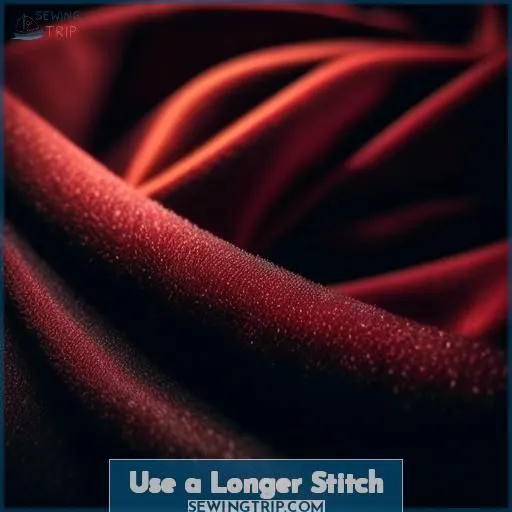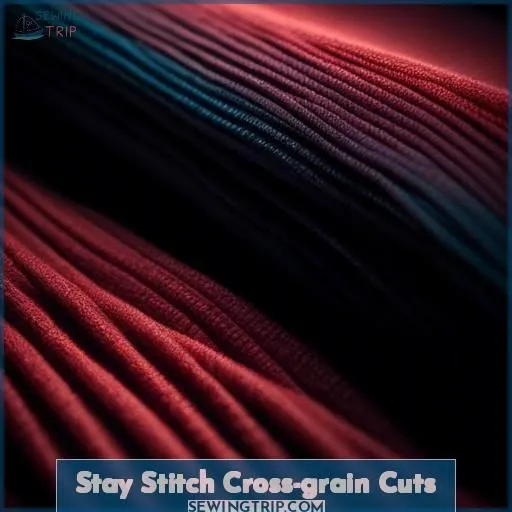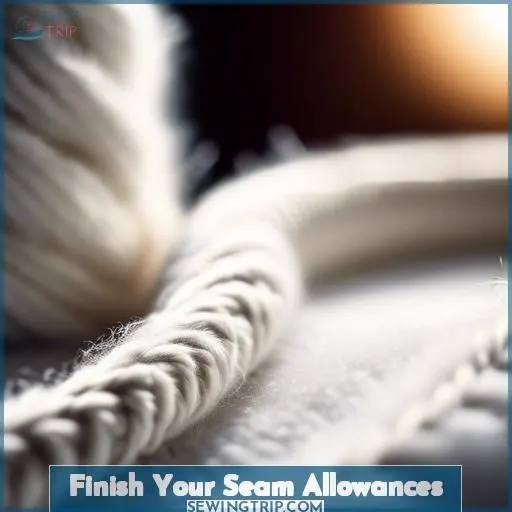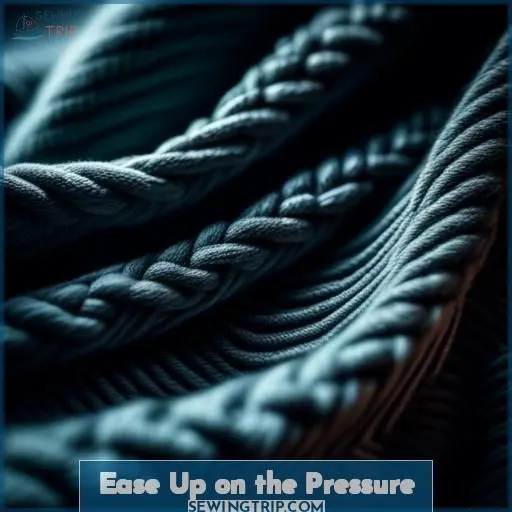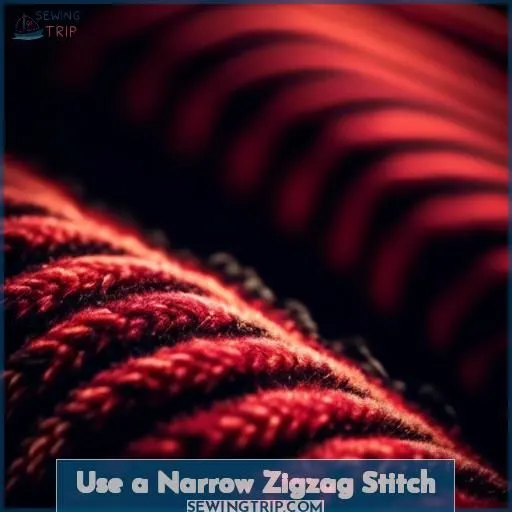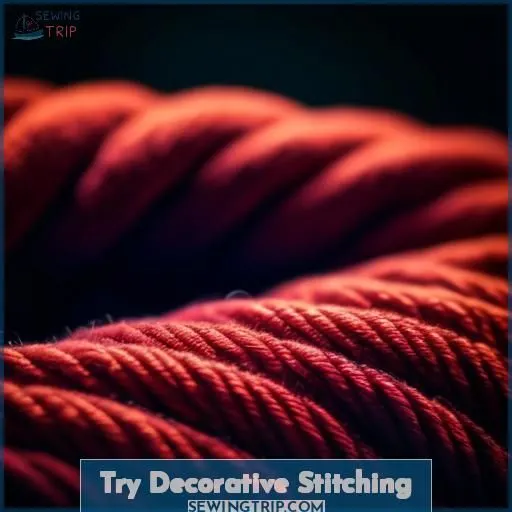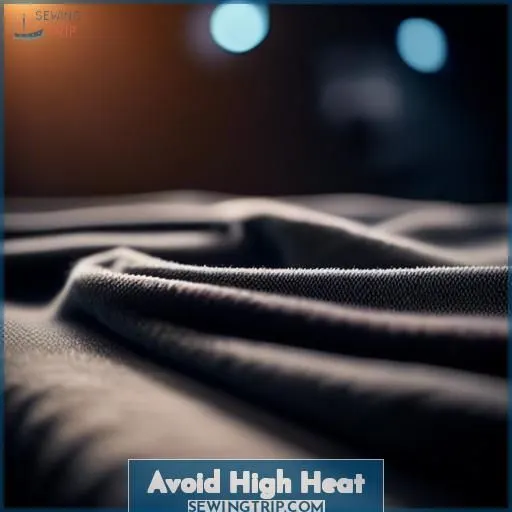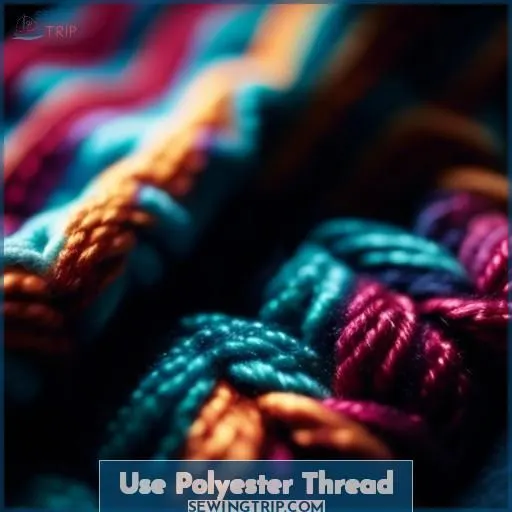This site is supported by our readers. We may earn a commission, at no cost to you, if you purchase through links.

This comprehensive guide unveils techniques tailored for flawless results with fleece fabric.
You’ll discover ideal stitch lengths, needles, and seam finishes, empowering you to create professional-looking garments or accessories.
Gain insights into handling stretch, reducing bulk, and achieving clean finishes.
Unlock your sewing potential and conquer fleece’s unique characteristics with confidence.
Table Of Contents
- Key Takeaways
- What Stitch to Use for Fleece ?
- Use a Longer Stitch
- Stay Stitch Cross-grain Cuts
- Choose a Ballpoint Needle
- Finish Your Seam Allowances
- Ease Up on the Pressure
- Use a Narrow Zigzag Stitch
- Try Decorative Stitching
- Avoid High Heat
- Use Polyester Thread
- Clean Your Sewing Machine
- Frequently Asked Questions (FAQs)
- Conclusion
Key Takeaways
- Use a narrow zigzag or lightning bolt stitch for stretchy areas in fleece projects.
- Adjust the stitch length to 1.5 or shorter for flawless results.
- Opt for a ballpoint needle for sewing fleece.
- Finish seam allowances with faux flat-felled seams or double top-stitched seams.
What Stitch to Use for Fleece ?
The best stitch to use for sewing fleece is a narrow zig-zag stitch. This stitch will give the seam some elasticity, preventing the stitches from breaking. If you have a serger, you can also use it to create a strong elastic seam. A straight stitch is not recommended for fleece as it tends to break more easily due to the fabric’s stretch.
If you have trouble with stitches sinking into the fleece and skipping, try adding a stabilizer along the seam.
Use a Longer Stitch
To sew fleece, you should use a longer stitch length than you’d for other fabrics. The recommended stitch length for non-stretch items is 5-4, while for stretch fabrics, you should adjust the stitch length to 5 or shorter.
It’s also essential to use a ballpoint needle to prevent damage to the fleece fabric.
Adjust Stitch Length to 3.5-4 for Non-stretch Items
When tackling fleece, remember, it’s all about the stitch length. Here’s a quick guide to get you stitching like a pro:
- Stitch Length Adjustments: Set between 3.5-4 for those non-stretchy projects.
- Fleece Stitch Settings: Your sewing machine’s settings are your best friend.
- Needle Selection for Fleece: Opt for a universal needle.
- Sewing Machine Stitch Types: Stick to the basics for a smooth ride.
Adjusting the stretch factor in your stitch length can make or break your project. So, keep your thread tension in check and let your sewing machine do the heavy lifting.
Adjust Stitch Length for Stretch Fabrics
Adjusting stitch length for stretch fabrics is crucial to prevent puckering and ensure a flawless finish.
For stretch items, use a longer stitch (8-10 stitches per inch).
For non-stretch items, adjust stitch length to 3.5-4.
Always choose a ballpoint needle to prevent damage.
Finish seam allowances with faux flat-felled seams or double top-stitched seams.
Ease up on the pressure foot to avoid distortion.
Use a narrow zigzag stitch for stretch items.
Try decorative stitching for embellishment.
Clean your sewing machine after fleece projects.
Use a Ballpoint Needle to Prevent Damage
When sewing fleece, it’s crucial to use a ballpoint needle to prevent damage. Adjust your stitch length to 5 or shorter for stretch fabrics. Compared to stretch needles, ballpoint needles are designed to enhance your sewing experience.
By choosing the right needle, you’ll unlock the secrets to flawless results in the ever-evolving world of sewing fleece.
Stay Stitch Cross-grain Cuts
Stay stitching is a crucial technique for preventing stretching in cross-grain cuts, especially when sewing with fleece. It involves sewing a row of stitches along the edge of the fabric, which helps to hold the shape and prevent distortion.
To stay stitch effectively, it’s essential to use a ballpoint needle, as it has a rounded tip that glides through the nap without damaging the fibers. Additionally, you’ll want to adjust your stitch length based on the stretch factor of your fabric.
For non-stretch items, a stitch length of 5-4 is recommended, while for stretch fabrics, a shorter stitch length of 5 or less should be used.
Once you’ve stay stitched your cross-grain cuts, you can move on to other sewing techniques. Zigzag stitch adjustments are another crucial aspect of sewing with fleece. For stretch items, a narrow zigzag stitch or lightning bolt stitch is recommended, with a stitch length of 1.
5 or shorter. These stitches provide built-in elasticity and help to maintain the shape of your project.
When it comes to seam finishes for fleece, there are several options to choose from. Zigzag raw edges, serging, trimming seams, pinking shears, and grading seam allowances are all effective methods for finishing your seams.
Remember to always consider the stretch factor of your fabric when selecting a seam finish, as some techniques may not be suitable for all types of fleece.
In conclusion, stay stitching cross-grain cuts is a meticulous process that underpins the success of your sewing projects. By following these techniques and adjusting your stitch length and needle selection based on the stretch factor of your fabric, you can achieve flawless results when working with fleece.
Choose a Ballpoint Needle
When sewing fleece, it’s essential to choose a ballpoint needle to prevent damage to the fabric. Adjust your stitch length to 3.5-4 for non-stretch items and to 1.5 or shorter for stretch items to achieve flawless results.
Adjust stitch length to
When it comes to sewing with fleece, adjusting your stitch length is crucial for achieving the best results.
For non-stretch items, a stitch length of 4-5 is recommended.
However, for stretch fabrics, you’ll need to adjust the stitch length to 1.5 or shorter.
Using a ballpoint needle can also prevent damage and ensure a smooth sewing process.
Don’t forget to stay stitch cross-grain cuts to prevent stretching.
Ease up on the pressure foot to avoid distortion.
5. 4 for non-stretch items and
To sew fleece, you need to understand its unique characteristics. Start by identifying fabric orientation, such as locating the selvage edge.
For non-stretch items, use a longer stitch (8-10 stitches per inch) and adjust stitch length for stretch fabrics. Use a ballpoint needle to prevent damage. Stay stitch cross-grain cuts to prevent stretching.
Finish seam allowances with faux flat-felled seams or double top-stitched seams.
Use a narrow zigzag stitch for stretch items and adjust stitch length to 1.5 or shorter. Try decorative stitching for embellishment, and avoid high heat when ironing or using fusible interfacing.
For zippers and reinforcements, reinforce zipper edges with woven fusible interfacing, use separating zippers for fleece garments, and lower the iron heat when fusing interfacing.
It’s okay to cheat on thread color for most seams, and dial back top thread tension for decorative stitching visibility. Clean your sewing machine after fleece projects, using a soft paintbrush to remove lint.
Consult the manual for cleaning procedures and avoid using compressed air for cleaning.
5 or shorter for stretch items.
Switching gears to stretch fabrics, you’ll want to grab a ballpoint needle. This little change makes a big difference, ensuring your stitches don’t turn into a battleground on the stretchy terrain of fleece.
Dial down your stitch length to 1.5 or less; it’s like choosing the right gear for a smooth sewing journey.
Finish Your Seam Allowances
After choosing the right ballpoint needle, it’s time to focus on finishing your seam allowances to ensure your fleece projects look polished and last longer.
- Fleece Fabric Grading: Trim your seam allowances in layers to reduce bulk. This trick makes your seams lay flat and look sharp, especially around those tricky corners.
- Finishing Options: Consider using a faux flat-felled seam or double top-stitched seams for a clean finish. These methods add durability and a touch of professionalism to your work.
- Fleece for Binding: Use fleece strips as binding to cover raw edges. It’s a clever way to add a cozy finish while ensuring your project remains stretchy and comfortable.
- Zig Zag Stitch: Employ a narrow zigzag stitch to finish the edges. This stitch allows the fabric to stretch without breaking the thread, perfect for fleece’s slight give.
Ease Up on the Pressure
When sewing with fleece, it’s crucial to ease up on the pressure foot to avoid distortion. This technique is particularly important when working with delicate fabrics like fleece, which can be prone to stretching and puckering if not handled with care.
By adjusting the pressure foot, you can ensure that your stitches are even and consistent, resulting in a professional-looking finish for your fleece projects.
In addition to pressure foot adjustments, the stitch length for fleece is also a key factor in achieving flawless results. For non-stretch items, a stitch length of 5-4 is recommended, while for stretch fabrics, it’s advisable to use a ballpoint needle and adjust the stitch length to 5 or shorter.
Ballpoint needles are designed specifically for fleece and can help prevent damage to the fabric, ensuring a smooth and seamless sewing experience.
To further enhance your fleece stitching techniques, consider using decorative stitching for added embellishment. This can help eliminate bulk and create a more polished look for your finished projects.
Additionally, it’s important to clean your sewing machine after working with fleece to prevent any build-up of lint or debris that could affect your stitch quality.
In summary, when sewing with fleece, it’s essential to ease up on the pressure foot, adjust stitch length, use ballpoint needles, and incorporate decorative stitching for a flawless finish. By following these techniques, you can unlock the secrets to successful fleece stitching and create beautiful, high-quality garments that will stand the test of time.
Use a Narrow Zigzag Stitch
When sewing with fleece, it’s essential to use the appropriate stitch to ensure durability and prevent damage to the fabric.
For stretch items, a narrow zigzag stitch is recommended.
This stitch is strong and compact, making it suitable for fleece fabric, which can be prone to stretching and warping.
To use a narrow zigzag stitch, adjust the stitch length to 5 or shorter, depending on the weight and stretch of the fleece.
This stitch will help to prevent the fabric from stretching out and distorting during sewing.
For Stretch Items, Use a Lightning Bolt or Narrow Zigzag Stitch
When sewing fleece, opt for a narrow zigzag stitch for stretch items.
Adjust the length to 5 or shorter.
For non-stretch pieces, go for a longer stitch with a length of 5-4.
Safeguard your fabric with a ballpoint needle.
Maintain a longer stitch for non-stretch items.
Remember to tweak the stitch length for stretch fabrics.
Finish seams neatly.
Whether it’s polar fleece or cotton, these tips will ensure your sewing projects turn out just right!
Adjust Stitch Length to 1.5 or Shorter
To sew flawlessly with fleece, remember these crucial tips:
- Adjust stitch length for stretch fabrics, using a ballpoint needle to prevent damage.
- Stay stitch cross-grain cuts to prevent stretching.
- Ease up on the pressure foot to avoid distortion.
- Use a narrow zigzag stitch for stretch items, adjusting stitch length to 1.5 or shorter.
By following these guidelines, you’ll ensure your fleece sewing projects aren’t only successful but also meticulously crafted, navigating the complexities of this ever-evolving realm.
Try Decorative Stitching
To reduce bulk in your fleece projects, consider grading your seam allowances. Keeping your cutting tools clean with rubbing alcohol ensures smooth cuts for a professional finish.
Eliminate Bulk by Grading Seam Allowances
To eliminate bulk and achieve optimal results when sewing with fleece, grading seam allowances is a must.
For needle and thread combinations, use a universal or jersey needle and polyester thread.
Adjust stitch length to 3.5-4 for non-stretch items and 1.5 or shorter for stretch fabrics.
Use a narrow zigzag or lightning bolt stitch for stretch items.
Decorative stitching can also enhance your project.
Remember to clean cutting tools with rubbing alcohol and avoid high heat when ironing or using fusible interfacing.
Clean Cutting Tools With Rubbing Alcohol
After slimming down your seam allowances, it’s time to give your cutting tools a spa day with rubbing alcohol.
This isn’t just about keeping them shiny; it’s about ensuring they’re disinfected, especially after tackling sweatshirt fleece projects.
Rubbing alcohol is a champ at sanitizing, making it perfect for your shears and scissors.
Just a quick wipe down, and you’re back in business, ready to slice through fleece like butter.
Avoid High Heat
As you transition from the finesse of decorative stitching, remember that fleece is a bit like a delicate flower in a summer’s heatwave—it doesn’t take kindly to high temperatures. When you’re prepping to iron or use fusible interfacing, think of it as coaxing rather than commanding.
- Fleece Fabric Selection: Choose your fleece with care, keeping in mind that high heat can flatten its lively nap.
- Sewing Techniques: Embrace the gentle art of pressure foot easing, letting your machine dance over the fabric without scorching its spirit.
- Thread Selection: Polyester thread is your trusty ally, enduring the journey without a fray.
- Needle Types and Sewing Machine Settings: A ballpoint needle and a cool-headed iron are your best friends, ensuring your fleece doesn’t face the fiery end.
So, keep your iron’s temper in check, use long pins to handle fleece’s bulk with grace, and after a sewing spree, treat your machine to a spa day with a thorough clean.
Use Polyester Thread
When it comes to sewing with fleece, one of the most crucial aspects is selecting the appropriate thread. Fleece fabric is typically made of 100% polyester, which makes it a popular choice for various sewing projects due to its ease of use, warmth, and softness.
However, using the wrong thread can lead to poor stitch quality, thread breakage, or damage to the fabric.
To ensure a successful sewing experience with fleece, it’s advisable to use a high-quality 100% polyester thread for both the top and bobbin threads. This thread choice is essential for both non-stretch and stretch items, as it provides the necessary strength and resilience to accommodate the unique properties of fleece fabric.
When working with fleece, it’s also essential to consider the type of fleece fabric you’re using. For instance, polar fleece is a medium to heavyweight fabric with a fluffy nap on both sides, while sweatshirt fleece is knitted on the outside and fluffy on the inside.
Micro fleece is a lightweight, thinner, and stretchier fabric commonly used for baby clothing. Each type of fleece may require slightly different thread choices and sewing techniques, so it’s essential to understand the specific fabric you’re working with.
In summary, using a high-quality 100% polyester thread for both the top and bobbin threads is crucial for sewing with fleece. This thread choice ensures strength, resilience, and compatibility with the unique properties of fleece fabric, ultimately leading to better stitch quality and a successful sewing experience.
Clean Your Sewing Machine
After finishing a project with fleece fabric, it’s essential to clean your sewing machine to maintain its performance and longevity.
De-lint your machine: Use a soft paintbrush, pipe cleaner, or a sewing machine lint brush to remove any lint or dust from the inside of your machine. Make sure to clean the bobbin area, feed dogs, and other accessible areas.
Consult your manual: Follow the instructions in your sewing machine’s owner’s manual for specific cleaning procedures. If you can’t find your manual, check with the manufacturer for a replacement.
Avoid using compressed air: Don’t use compressed air to blow out lint and dust, as it can push the lint further into your machine and create problems.
Remember to clean your sewing machine regularly, especially after sewing with fabrics that produce more lint, such as fleece or velvet.
After Fleece Projects, Clean Your Sewing Machine
After completing a fleece project, it’s crucial to clean your sewing machine. Remove lint with a mini vacuum or brush, clean the tension discs, and change needles regularly. Don’t forget to clean the bobbin case to ensure your next project runs smoothly.
Use a Soft Paintbrush to Remove Lint
To prevent lint buildup on fleece fabric, you can use a fabric shaver or a lint roller. If you prefer a manual tool, a fabric comb or pumice stone can be effective, although they may require more passes to fully clear away pills and can potentially stretch or distort the fabric.
Sweater stones tend to disintegrate over time, so you may need to vacuum the floor after depilling your sweater.
For removing lint from fleece, vinegar can be a helpful addition. Adding distilled white vinegar to your washing machine’s rinse cup can help prevent static cling and soften the fabric, making it easier to remove lint.
When it comes to cleaning your sewing machine after working with fleece, it’s important to follow the recommended settings. Lower the presser foot tension if your machine has that adjustment option, and use long pins for sewing around curves or over multiple layers of fabric.
To properly disassemble a sewing machine for cleaning, consult your machine’s manual for specific instructions. Avoid using compressed air for cleaning, as it can lodge the lint even deeper into your machine.
Consult Manual for Cleaning Procedures
Consulting the manual for cleaning procedures is crucial for maintaining your sewing machine’s performance and longevity.
Regular maintenance is recommended, such as:
Cleaning the interior of the bobbin assembly and case
Cleaning the tension disks
Cleaning under the throat plate
Additionally:
Oiling all necessary parts
Taking your machine to a dealership or service center for a standard check-up every two years
Avoid Using Compressed Air for Cleaning
Avoid using compressed air for cleaning your sewing machine.
Compressed air can pose potential hazards, such as entering the bloodstream and causing air embolisms, leading to severe health issues.
The moisture in compressed air can cause metal parts to rust.
Instead, use a cleaning brush provided by the manufacturer or a larger soft brush to remove lint from your sewing machine.
Frequently Asked Questions (FAQs)
Why should I use a longer stitch length when sewing with fleece?
You’ll want to use a longer stitch length (8-10 stitches per inch) when sewing fleece. This prevents the stitches from perforating and damaging the nap, keeping your fleece looking smooth and professional.
How can I avoid stretching the fabric when laying out pattern pieces?
To prevent stretching, consider the nap direction when laying out fleece pattern pieces. Thoroughly examine the nap and ensure all pieces are positioned in the same direction for a consistent, professional look.
What type of needle should I use for sewing fleece?
Visualize gliding your sewing machine needle smoothly through fleece’s plush fibers. For this fabric, use a ballpoint or stretch needle to prevent snagging and skipped stitches.
How do I finish my seam allowances effectively?
To finish fleece seam allowances neatly, try serging, zigzagging raw edges, trimming with pinking shears, or grading seams by cutting layers.
What is the best way to handle bulky seams while sewing with fleece?
You’ll want to employ a hump jumper attachment on your machine for bulky fleece seams. This nifty device lifts the machine’s presser foot over thick areas, preventing distortion and ensuring smooth seams.
Conclusion
Mastering what stitch to use for fleece isn’t just about enhancing your sewing projects; it’s about transforming them.
By adjusting stitch lengths, choosing the right needle, and employing specific seam finishes, you’re set to achieve professional-looking results.
Dive into your next fleece project with confidence, armed with these essential tips.

